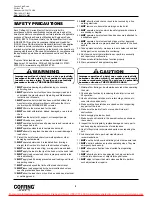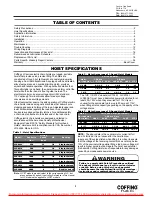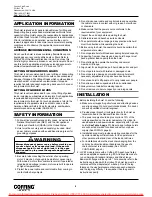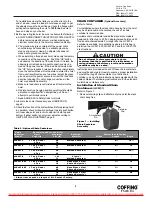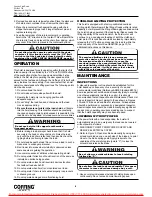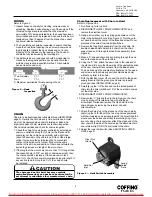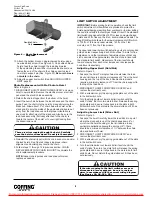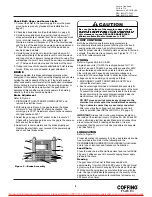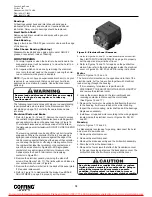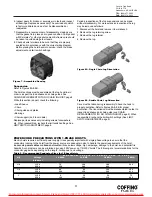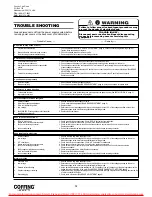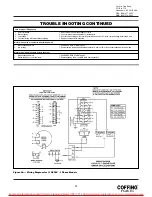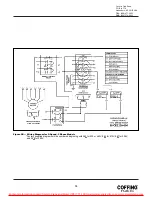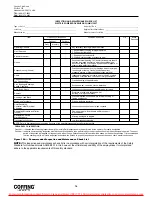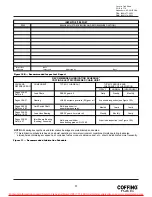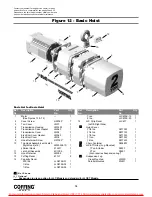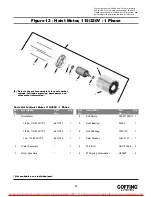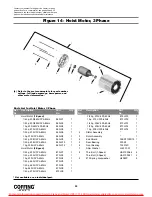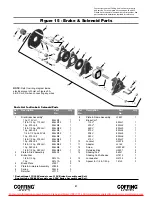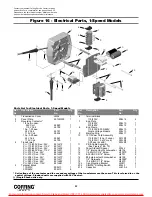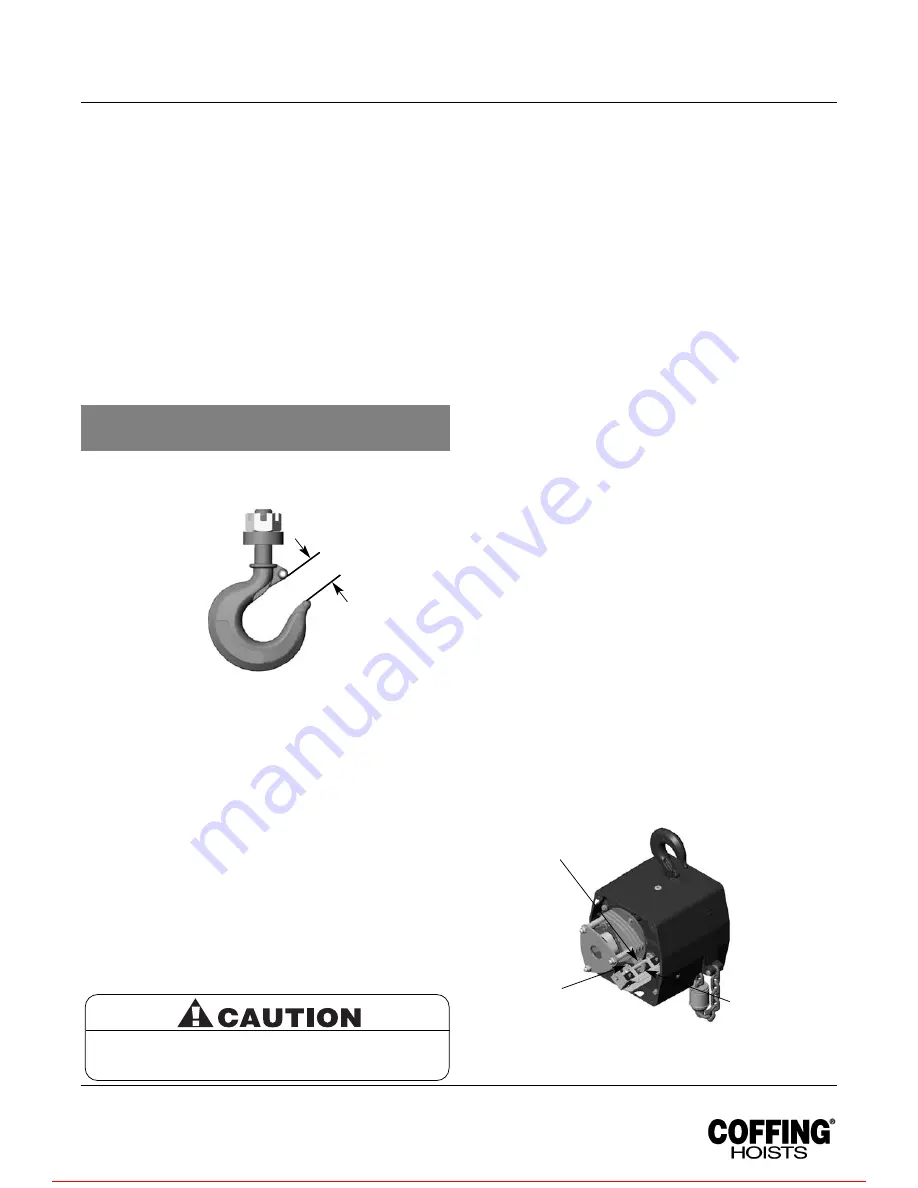
7
Country Club Road
P.O. Box 779
Wadesboro, NC 28170 USA
TEL: (800) 477-5003
FAX: (800) 374-6853
HOOKS
Refer to Figure 2.
1. Inspect hooks once daily for cracking, extreme wear or
spreading. Replace hooks showing any of these signs. If the
throat openings are spread wider than the maximum
permissible 15% increase listed here, the hooks have been
overstressed and must be replaced. Any hook that is bent or
twisted more than 10 degrees from the plane of an unbent
hook must also be replaced.
2. The hook latches should be inspected to ensure that they
close the hook throat opening in a secure manner when a
load is applied. Inspect the hook shank and nut for any
stripping of the threads or other damage. The hook nut
should be fully restrained by the retaining pin.
3. In addition to above, load hooks should be inspected for
cracks by the magnetic particle, dye penetrant or other
suitable crack testing inspection method. This should be
done at least once a year.
1 Ton & Under
1
11
/
32
"
1
7
/
32
"
2 ton
1
11
/
32
"
1
11
/
32
"
(*) Maximum permissible throat opening of hook.
CHAIN
Chain is to be kept clean and lubricated (See LUBRICATION,
page 9). Visually check chain every time hoist is used. Hoist
must not be operated when chain is twisted or kinked. An
important phase of hoist maintenance is chain inspection.
Check individual links and check for chain elongation.
1. Check the chain for overall wear or stretch by selecting an
unworn, unstretched length of chain (at the slack end for
example). Let the chain hang vertically with a light load
(about 20 pounds) on the chain to pull it taut. Use a large
caliper to measure the outside length of a convenient
number of links (about 12 inches). Measure the same
number of links in a used section of chain and calculate the
percentage increase in length of the worn chain.
2. If the length of the worn chain is more than 1½% longer than
the unused chain (0.015" per inch of chain measured), then
the chain should be replaced. If the chain is worn less
than 1½%, check it at several more places along its length. If
any section is worn more than 1½%, the chain should
be replaced.
Chain Replacement with Chain in Hoist
Refer to Figures 3 & 4.
1. Run hook up to its top limit.
2. DISCONNECT HOIST FROM POWER SUPPLY and
remove the electrical cover.
3. Using a screwdriver, pry the spring guide plate out of the
slots in the limit switch nuts (See Figure 3). Turn the gold
nut back to about the center of the threaded screw. Do not
disconnect the wires from the limit switches.
4. Remove the load block assembly from the old chain. On
double-chained hoists detach the chain from the chain
support and pull it through the load block assembly (See
Figure 4).
5. Make a “C” shaped chain link by grinding through the end
link on the load end of the old chain.
6. Using the “C” link, attach the new chain to the load end of
the old chain. Be sure that the welds of the upstanding links
of the new chain will face outward from the load sheave.
The end links must be oriented for attachment to the dead-
end screw and the chain support (double-chained only)
without any twist in the chain.
7. With the electrical cover off, connect the hoist to the power
supply. Be sure that the green ground wire is properly
grounded (See INSTALLATION, page 4).
8. Carefully jog the “UP” button and run the joined pieces of
chain into the hoist until about 15" of the new chain comes
out the other side.
9. DISCONNECT HOIST FROM POWER SUPPLY.
10. Remove the “C” link and the old chain. Remove the chain
stop by prying off its retaining ring with a flathead
screwdriver. If attached, remove the old chain from the
chain stripper by removing the retainer clip and
attachment pin.
11. Attach the chain stop to the slack end of the new chain by
capturing the 12th link with the two stop halves positioned
with their tapered ends pointing towards the hoist. Slide the
sleeve over the halves and attach the retaining ring. If you
are not using a chain container, attach the slack end of the
new chain to the side of the hoist using the attachment pin
and retainer clip. DO NOT allow twists in the chain.
12. Adjust the lower limit switch (See ADJUSTING LOWER
LIMIT, page 8).
Figure 3 — Limit Switch Assembly
“
“X
X”
” D
Diim
me
en
ns
siio
on
n*
*
H
Ho
oiis
stt
T
To
op
p
B
Bo
otttto
om
m
C
Ca
ap
pa
ac
ciitty
y
H
Ho
oo
ok
k
H
Ho
oo
ok
k
The chain used on this hoist has very carefully
controlled dimensions and has been heat treated. Do
not attempt to substitute other manufacturer’s chain.
X
Figure 2 — Hook
Inspection
Spring
Guide
Plate
Silver Nut
(Down)
Gold Nut
(Up)
For more information contact: Sievert Crane and Hoist, (708) 771-1600, parts@sievertelectric.com, www.sievertcrane.com


